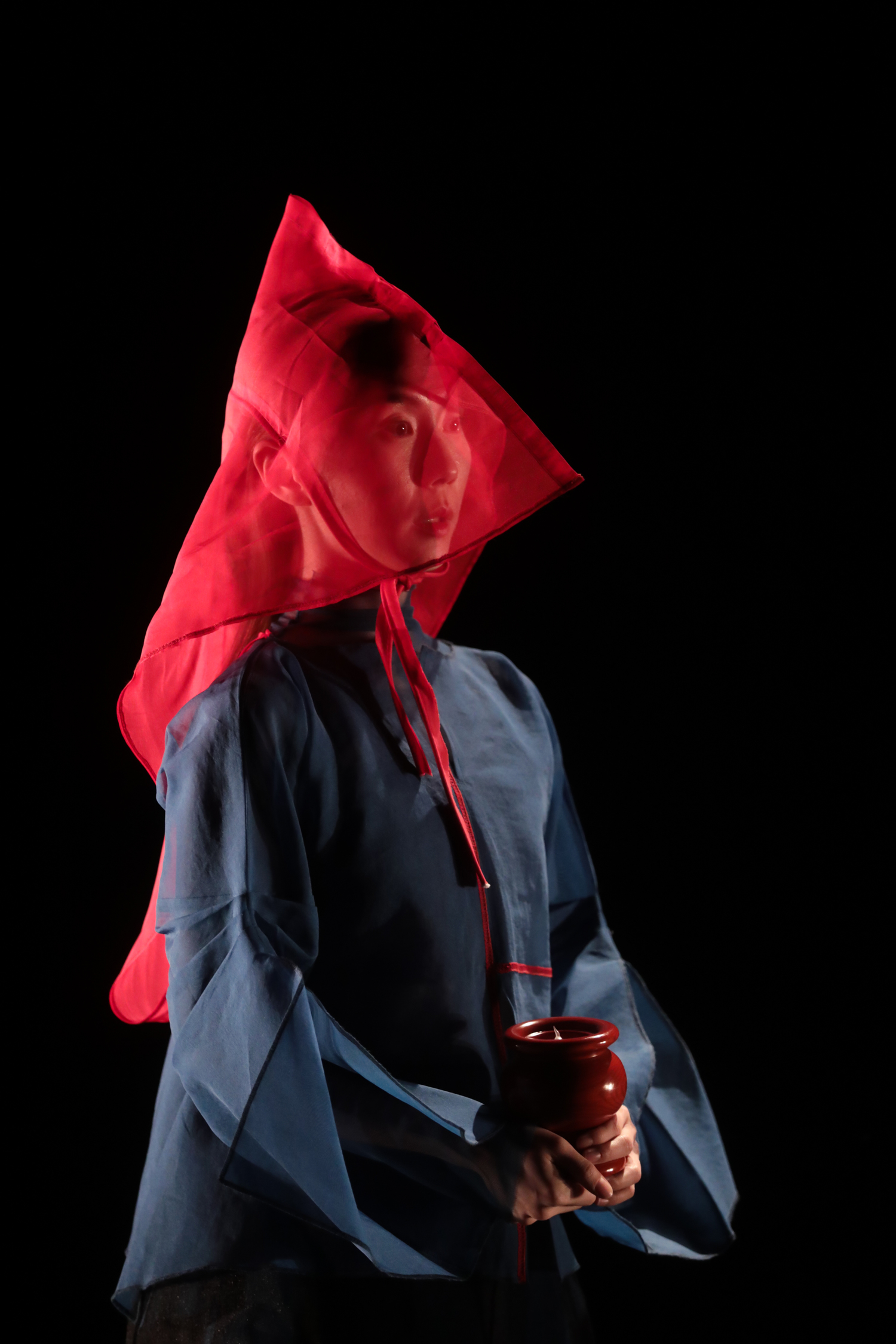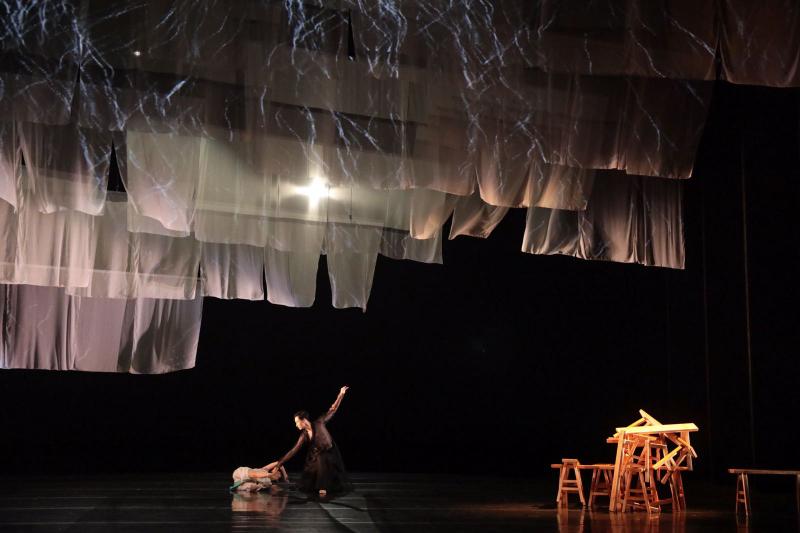Review: TALE OF THREE CITIES Gathers 'Traditions' at Kwai Tsing Theatre

by Han Hyo-Lim (Han Dance Project)
Photo Credit: Mak
There is always a dilemma to take a stand, and having mixed feelings about viewing a Hong Kong Dance Company production. In the last two years, I have seen several productions by the Company, artistically led by veteran dancer and choreographer Yang Yuntao, and I was refreshed by his new pathway of changing the Company from just showcasing traditional Chinese dance to merging tradition with contemporarily artistic visions and experiments.
Storytelling in theatrical form through traditional dance is what Mr Yang really emphasises in his past repertoire, either in his own work or works he curated for the Company. From L'AMOUR IMMORTAL, a personal favourite of the adaptation of the 1987 Hong Kong film A CHINESE GHOST STORY, which professes experimentation in physical theatre without music more than the ballet-merged traditional Chinese dances, to CHINESE HERO: A LONE EXILE, another adaptation based on the Hong Kong classic comic by Ma Wing-Shing, which demands arch-plot narratives in not just choreography but every other aspect, Mr Yang never tires to explore the possibility in showcasing traditional Chinese dances through different topics and formats.
His recent curations of REVERIES OF THE RED CHAMBER and VIPASSANA, which both are experimental productions on dance, even to redefine what 'dance theatre' means, really speak out what kind of artistic direction Mr Yang is heading with the Hong Kong Dance Company.
It is exciting to see an artist continually exploring new forms for his company's growth through a dance form which probably is considered as a dying art. However, these kinds of explorations do lead to unevenly crafted productions with blind-spots that probably initiate the fundamental problem of 'style over substance'.
TALE OF THREE CITIES is another venture by the Company, showcasing three short dance pieces by three different Companies in three 'cities' in East Asia: Bulareyaung Dance Company from Taitung in Taiwan, Han Dance Project from Seoul in Korea, and Hong Kong Dance Company from Hong Kong, which I think still embraces that problem.
The coherent thematic thread of the three pieces in TALE OF THREE CITIES is to express the artists' personal linkages towards the three cities respectively through the traditional dances of each city's culture.
TALE OF THREE CITIES starts with Taitung's representative, Bulareyaung Pagarlava's 'Qacilay', a piece of 10 male dancers that celebrates the Paiwan culture in Taitung. Mr Pagarlava states that, as a Paiwaness, he urges himself to explore his 'roots' in his dance creation, to speak to his audience by expressing who he is.

Photo Credit: Mak
Personally, Mr Pagarlava's piece is the most provocative among the three. With really simple concept and design, 'Qacilay' simulates my affection in grounded rituals that speaks volume through exploring one's inner self. While the 10 dancers hold hands as a chain, chanting through the whole piece, projections of different totems that relate back to the Paiwan ancient culture are shown at the back, one by one along the different chapters of the chant.
Visually, there is nothing more than that. To sum up the piece by one word will be 'naked'. Not only as a matter of fact that the dancers are all naked (apart from having thongs wrapped around their private parts), but the nature of the performance is also stripped to minimal. It is raw, it is ferocious, it is also highly masculine, but it gives me a feeling that I am channelling between heaven and earth through the dancers' genuine respect to mother nature. I can see the bonding between the dancers, as well as their attempt to communicate with the audience, to share their pride as Paiwanese without being artificial. It is that clean-slate honesty that wins my affection.
For performing rituals, communication is key, and while 'Qucilay' has successfully made a dialogue between the piece and the audience, 'Furious Sea - Memory of Ube' by Han Hyo-Lim, on the contrary, does not hit that mark with enough strength.
Inspired by the accident of Chosei Coal Mine in February 1942, Han develops a dancing suite to pay tribute to and commemorate the Korean miners who lost their lives, as well as to express her 'anger' towards the incident, having civilians of her own country innocently lost their lives during the Japanese occupation.

Photo Credit: Mak
No doubt that 'Furious Sea' embodies an engaging structure with immense ritual glamour in the choreography that exudes a type of melancholy. With the change of music, we go through from solemn requiem to the anguish of the 'ghosts' to a finale of peace and beauty. One cannot dismiss the absolute calculated structure to invite the audience to engage with the piece.
However, it is also the problem of the meticulous calculation of the piece that makes me not feeling the urge to empathise or to be having heated emotions about the death of the Korean miners. It is beautiful and spectacular to a point that I sense the lack of honesty in the dancers' performance, showing the audience more on their fundamental skills and their precision in the formation of sequences instead of embodying the ritual, the devastating reason of why they dance for the dead.
In return, I see beautiful aesthetics that I share enjoyment with, but unfortunately, the performance does not give more than that.
On the aspect of aesthetics, 'Four Seasons' by Xie Yin, representing the Hong Kong Dance Company for the night, starts with a much more honest revelation of what her piece is about, but still a bit distant to the audience by the end of it.
By slowly rising up the black curtain, we see a vast canvas of floating white curtains in layers across the stage, with wooden benches situated underneath them. It suggests this might be the back garden of a traditional Chinese village house with hanged washings.

Photo Credit: Mak
We hear birds chirping while the whole stage is slowly revealed. Once the music starts, an image of the sea is projected across the white curtains. These curtains are then slowly raised up to the border above the stage, signifying the beginning of the piece.
Again, it is spectacular and glamorous to start the piece like that. 'Four Seasons' is inviting enough for me to listen to what Ms Xie has to express about this once-a-water-village. What would she have installed after? It is still promising to see the mixture of Vivaldi's music along with the traditional Chinese dance of Flower Drum, an interesting hybrid result that still sparks genuine connections between me and the dancers, as Hong Kong is a place of East-meets-West.
However, that does not last long. Vivaldi's THE FOUR SEASONS obviously has structured his piece through different movements, and I can see that Ms Xie is using those movements to construct her own 'movements' in her piece. It is a trial, but I do not think it holds to the end. The music does have its own connotations, and Ms Xie's choreography and vision, divided in chunks and derived from different inspirations of choreographic style in both the traditional and the modern canons, leads to a result that it is trying to fit and gain results from an experiment, while the fundamental narrative of expressing the author's passion has been diminished along the piece. At the end, I feel that Ms Xie is trying to have a dialogue with me, a Hongkonger, about her perception of Hong Kong, but it is still alien to me. It is the Flower Drum dance that is Ms Xie's 'root' way more than the city itself.
To conclude, TALE OF THREE CITIES has its ups and downs. I do appreciate the Company for doing exchanges with other companies in other close areas, and to keep on doing experiments. However, I do think it is time for the Company to pinpoint the issues of these past experiments and try to develop pieces that are not just experimental but mature and inspirational.
TALE OF THREE CITIES at Kwai Tsing Theatre, Hong Kong
Closed on 4th February 2018
Videos
